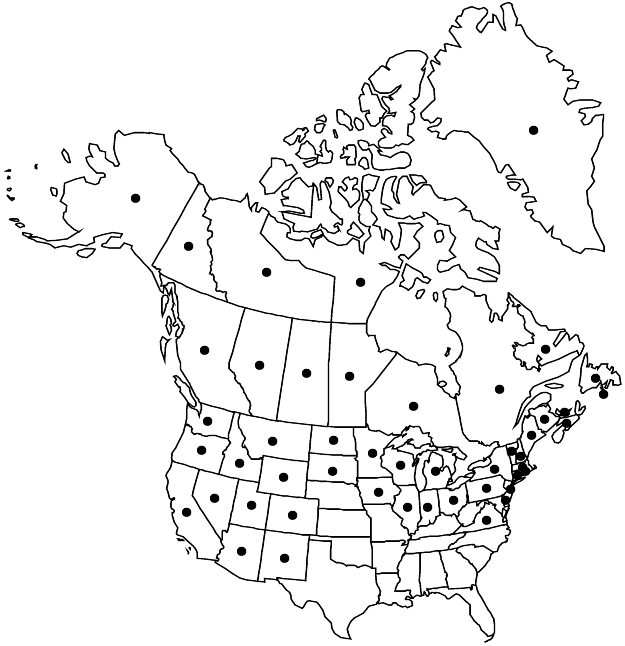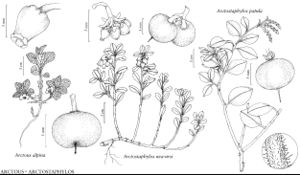Difference between revisions of "Arctostaphylos uva-ursi"
Syst. Veg. 2: 287. 1825,.
FNA>Volume Importer |
FNA>Volume Importer |
(No difference)
| |
Revision as of 23:04, 16 December 2019
Shrubs, prostrate, mat-forming, 0.1–0.5 m; burl sometimes present, sometimes epicormic; twigs usually sparsely short-hairy, sometimes long-hairy or short and/or long glandular-hairy. Leaves separated proximally, overlapping distally, bifacial; petiole 2–4 mm; blade light green abaxially, dark green adaxially, shiny, usually oblanceolate to obovate, sometimes narrowly elliptic, 1–2.5 × 0.5–1.5 cm, base cuneate (not clasping), margins entire, often cupped, surfaces smooth, sparsely puberulent, glabrescent. Inflorescences racemes (simple or 1-branched); immature inflorescence pendent, (congested), axis 0.3–1 cm, 1+ mm diam., usually sparsely short-hairy, sometimes long-hairy or short glandular-hairy; bracts not appressed, scalelike, narrowly deltate, 2–6 mm (larger than buds), apex acuminate, surfaces glabrous. Pedicels 2–4 mm, glabrous. Flowers: corolla white to pink, urceolate; ovary glabrous. Fruits globose, 6–12 mm diam., glabrous. Stones distinct. 2n = 26, 52.
Phenology: Flowering winter–early summer.
Habitat: Coastal dunes, open, acidic temperate and boreal forests, high montane on acidic, sandy, or rocky soils
Elevation: 0-3100 m
Distribution

Greenland, St. Pierre and Miquelon, Alta., B.C., Man., N.B., Nfld. and Labr., N.W.T., N.S., Nunavut, Ont., P.E.I., Que., Sask., Yukon, Alaska, Ariz., Calif., Colo., Conn., Del., Idaho, Ill., Ind., Iowa, Maine, Mass., Mich., Minn., Mont., Nev., N.H., N.J., N.Mex., N.Y., N.Dak., Ohio, Oreg., Pa., R.I., S.Dak., Utah, Vt., Va., Wash., Wis., Wyo., Central America (Guatemala), Eurasia.
Discussion
Arctostaphylos uva-ursi exhibits great variation in indument associated with the young twigs. Most of this variation has historically been separated into subspecies, except that a recent analysis of the group suggested environmentally-based variation in these characters (T. J. Rosatti 1987b). This is the most widely distributed of all Arctostaphylos species and is the only one found outside of North America. Two ploidy levels are common, and populations sometimes contain both diploids and tetraploids. More work on this widespread species will likely elucidate its variation in morphology and ploidy. Infraspecific taxa may well be recognized once these patterns are further assessed.
A form with striking deep red to purple autumnal corollas (often blooming also in spring with normal-colored corollas) occurs on Cape Cod and Nantucket Island, Massachusetts.
Most populations lack burls and are killed by fire; throughout the range in North America are occasional populations or individuals that have small, sometimes epicormic burls. This has been noted in California, parts of Canada, and New York. With more observations this distribution may become clearer.
A form with somewhat puberulent and larger leaves has been described as Arctostaphylos ×media Greene. It occurs along the northern California coast and in Oregon and Washington. It is assumed to be a hybrid between A. uva-ursi and A. columbiana. Similarly, in the Rocky Mountains in areas with both A. uva-ursi and A. patula, hybrids have been called A. coloradensis Rollins.
